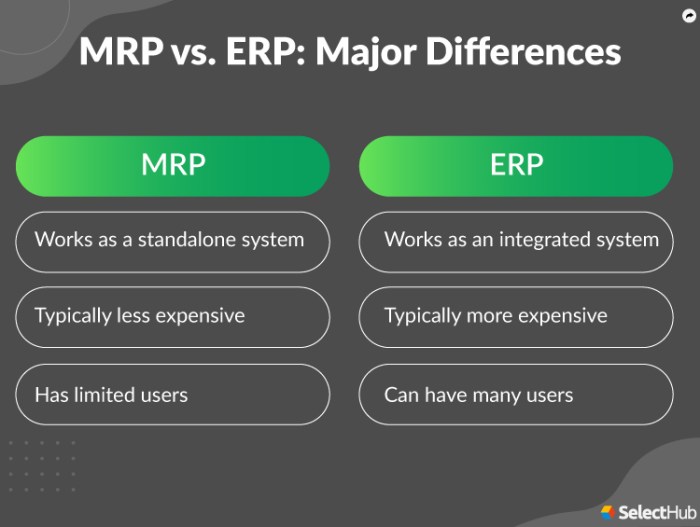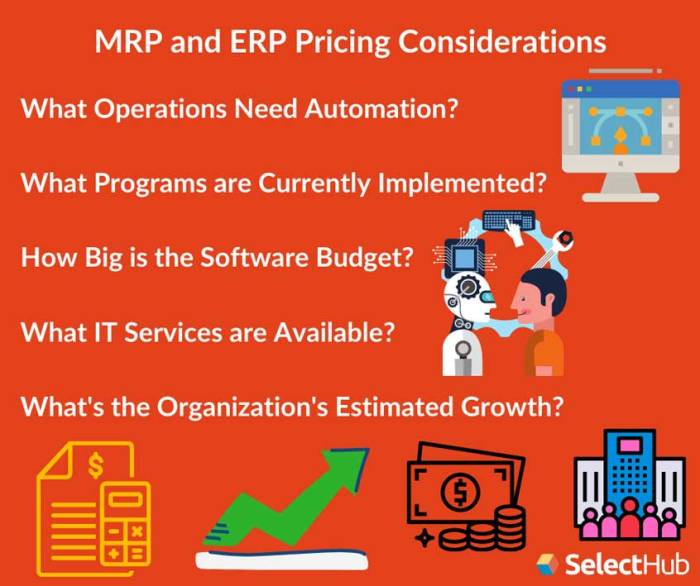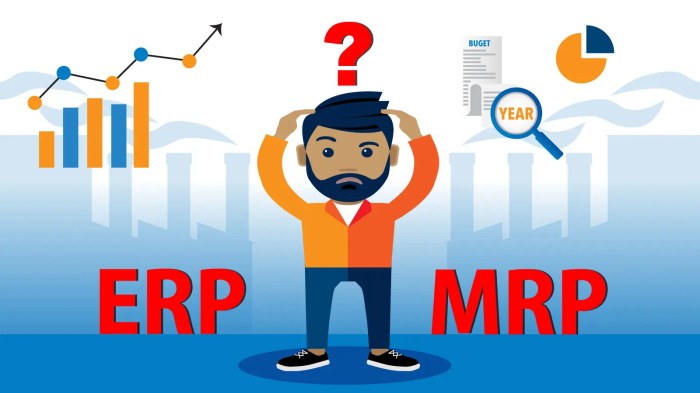ERP/MRP Systems: The Key to Unlocking Business Efficiency – In today’s competitive business landscape, organizations are constantly seeking ways to streamline operations, reduce costs, and improve decision-making. Enter ERP/MRP systems, the key to unlocking business efficiency and driving success. These integrated software solutions offer a comprehensive suite of tools that can transform the way businesses operate, leading to significant improvements in productivity, customer satisfaction, and profitability.
ERP (Enterprise Resource Planning) and MRP (Manufacturing Resource Planning) systems are designed to seamlessly integrate various business functions, including inventory management, production planning, order processing, and customer relationship management. By centralizing data and automating processes, these systems eliminate inefficiencies, improve communication, and provide real-time visibility into business operations.
Introduction
ERP (Enterprise Resource Planning) and MRP (Material Requirements Planning) systems are software solutions designed to optimize business operations by integrating various functional areas within an organization. These systems provide a centralized platform for managing and streamlining processes, from inventory control and production planning to financial management and customer relationship management.
Implementing ERP/MRP systems offers numerous benefits to businesses, including improved efficiency, reduced costs, and enhanced decision-making. By automating tasks, eliminating redundant processes, and providing real-time data visibility, these systems enable organizations to operate more effectively and make informed decisions based on accurate and up-to-date information.
Benefits of ERP/MRP Systems
- Improved Efficiency:ERP/MRP systems automate manual tasks and streamline processes, reducing the time and effort required to complete operations. This increased efficiency allows businesses to allocate resources more effectively and focus on strategic initiatives.
- Reduced Costs:By optimizing inventory levels, reducing waste, and improving supply chain management, ERP/MRP systems can significantly reduce operating costs for businesses. This cost reduction can be realized through reduced inventory holding costs, improved production planning, and enhanced purchasing efficiency.
- Enhanced Decision-Making:ERP/MRP systems provide real-time data visibility and reporting capabilities, enabling businesses to make informed decisions based on accurate and up-to-date information. This enhanced decision-making can lead to improved strategic planning, better resource allocation, and increased profitability.
Key Components of ERP/MRP Systems: ERP/MRP Systems: The Key To Unlocking Business Efficiency

ERP and MRP systems are complex software solutions that integrate various business functions into a single platform. These systems consist of several key components that work together to streamline business processes and improve operational efficiency.
The core components of ERP/MRP systems include:
- Inventory Management:Tracks and manages inventory levels, including raw materials, work-in-progress, and finished goods. It helps businesses optimize inventory levels, reduce waste, and improve inventory turnover.
- Production Planning:Plans and schedules production activities based on demand forecasts, inventory availability, and production capacity. It helps businesses optimize production schedules, reduce lead times, and improve production efficiency.
- Order Processing:Manages the entire order fulfillment process, from order entry to delivery. It automates order processing, reduces errors, and improves customer satisfaction.
- Customer Relationship Management (CRM):Manages interactions with customers, including sales, marketing, and customer service. It helps businesses build stronger customer relationships, increase sales, and improve customer loyalty.
These components are tightly integrated and work together to create a comprehensive business management system. By sharing data and processes across different departments, ERP/MRP systems eliminate data silos, reduce redundancies, and improve overall business efficiency.
With the growing adoption of ERP/MRP systems, businesses are experiencing enhanced efficiency and streamlined operations. These systems provide real-time data and insights, empowering businesses to make informed decisions. If you’re interested in exploring a different industry, check out Selling Cellphones in Riyadh: A Comprehensive Guide for valuable insights into the Saudi Arabian market.
ERP/MRP systems can also play a crucial role in optimizing supply chains and inventory management, ensuring businesses have the right products at the right time to meet customer demands.
Implementation Considerations
Implementing ERP/MRP systems effectively requires careful planning and execution. Key considerations include:
Business Process Analysis
Thoroughly analyze existing business processes to identify areas for improvement and optimization. This will help align the system with your specific operational needs.
Data Migration
Plan and execute data migration meticulously to ensure accurate and complete transfer of data from legacy systems. This process should be managed carefully to avoid data loss or corruption.
User Training, ERP/MRP Systems: The Key to Unlocking Business Efficiency
Provide comprehensive training to all users to ensure they are proficient in using the system. This includes both technical training and training on business process changes. Thorough training empowers users to maximize the system’s functionality and drive successful adoption.
Benefits of ERP/MRP Systems
ERP/MRP systems offer a wide range of benefits for businesses of all sizes. By integrating various aspects of an organization’s operations, these systems can streamline processes, improve efficiency, and reduce costs. Some of the key benefits of implementing ERP/MRP systems include:
- Increased productivity: ERP/MRP systems can help businesses to improve productivity by automating tasks, reducing errors, and improving communication between different departments.
- Improved customer satisfaction: ERP/MRP systems can help businesses to improve customer satisfaction by providing better visibility into customer orders, tracking customer interactions, and resolving customer issues more quickly.
- Reduced operating costs: ERP/MRP systems can help businesses to reduce operating costs by automating tasks, reducing inventory levels, and improving supply chain management.
Real-World Examples
Many businesses have successfully leveraged ERP/MRP systems to achieve significant improvements. For example, the manufacturing company Caterpillar used an ERP system to reduce its inventory levels by 20%, resulting in savings of over $1 billion.
Challenges of ERP/MRP Implementation
ERP/MRP implementation is not without its challenges. Organizations often face resistance to change, data accuracy issues, and integration difficulties.
Overcoming these challenges requires careful planning, effective communication, and a commitment to data integrity. Organizations must also be prepared to invest time and resources in training and support to ensure a successful implementation.
Resistance to Change
One of the biggest challenges of ERP/MRP implementation is resistance to change. Employees may be reluctant to adopt new systems and processes, especially if they are comfortable with the existing ones.
To overcome resistance to change, organizations must:
- Communicate the benefits of the new system to employees.
- Involve employees in the implementation process.
- Provide training and support to employees.
- Create a culture of change within the organization.
Data Accuracy Issues
Another challenge of ERP/MRP implementation is data accuracy issues. Data accuracy is essential for the system to function properly. However, data accuracy can be compromised by a variety of factors, such as:
- Data entry errors
- Data inconsistency
- Data duplication
To ensure data accuracy, organizations must:
- Establish data governance policies and procedures.
- Implement data validation and verification processes.
- Train employees on data entry best practices.
Integration Difficulties
ERP/MRP systems must be integrated with other systems in the organization, such as financial systems, CRM systems, and supply chain management systems. Integration difficulties can occur when these systems are not compatible or when the data is not properly mapped.
To overcome integration difficulties, organizations must:
- Choose an ERP/MRP system that is compatible with other systems in the organization.
- Map the data between the ERP/MRP system and other systems.
- Test the integration thoroughly before going live.
Comparison with Traditional Business Systems

ERP/MRP systems offer significant advantages over traditional business systems, which were often characterized by fragmented and siloed data management. Traditional systems relied on multiple standalone applications for different business functions, leading to data duplication, inconsistencies, and limited visibility across the organization.
In contrast, ERP/MRP systems provide a centralized and integrated platform that streamlines data management and facilitates real-time information sharing across all departments. This eliminates data silos, improves collaboration, and enables businesses to make more informed decisions based on a comprehensive view of their operations.
Advantages of ERP/MRP Systems over Traditional Systems
- Centralized data management:ERP/MRP systems consolidate data from various business functions into a single, central repository, eliminating data duplication and inconsistencies.
- Improved collaboration:Real-time data sharing across departments enhances collaboration and communication, enabling teams to work more effectively together.
- Enhanced decision-making:Access to real-time and accurate data empowers businesses to make more informed decisions, leading to improved operational efficiency and profitability.
- Increased productivity:Automated processes and streamlined workflows reduce manual tasks, freeing up employees to focus on higher-value activities.
- Improved customer service:Centralized customer information and order tracking capabilities enhance customer service and satisfaction.
Disadvantages of Traditional Business Systems
- Data silos:Multiple standalone applications lead to data duplication and inconsistencies, hindering data accessibility and analysis.
- Limited visibility:Fragmented systems provide a limited view of business operations, making it difficult to make informed decisions.
- Poor collaboration:Siloed systems hinder communication and collaboration between departments, leading to inefficiencies and missed opportunities.
- Manual processes:Reliance on manual processes increases the risk of errors and delays, reducing productivity and efficiency.
- Lack of scalability:Traditional systems often struggle to scale as businesses grow, leading to performance issues and increased maintenance costs.
Final Wrap-Up

In conclusion, ERP/MRP systems are essential tools for businesses looking to optimize their operations, enhance decision-making, and gain a competitive edge. With careful planning, successful implementation, and ongoing optimization, businesses can harness the full potential of these systems and unlock the path to business efficiency and long-term success.
Quick FAQs
What are the benefits of implementing ERP/MRP systems?
ERP/MRP systems offer numerous benefits, including improved efficiency, reduced costs, enhanced decision-making, increased productivity, improved customer satisfaction, and reduced operating costs.
What are the common challenges associated with ERP/MRP implementation?
Common challenges include resistance to change, data accuracy issues, integration difficulties, and the need for extensive user training.
How can businesses overcome the challenges of ERP/MRP implementation?
Businesses can overcome challenges by conducting thorough business process analysis, ensuring data accuracy, providing comprehensive user training, and adopting a phased implementation approach.
What are the key considerations for successful ERP/MRP implementation?
Key considerations include defining clear project goals, securing executive sponsorship, involving key stakeholders, and establishing a dedicated project team.
What are the latest trends in ERP/MRP systems?
Emerging trends include cloud-based solutions, artificial intelligence, predictive analytics, and the integration of IoT devices.





